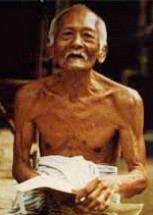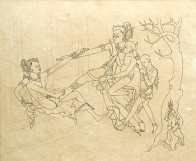I Gusti Nyoman Lempad

BALI'S MOST WELL-KNOWN ARTIST, I Gusti Nyoman Lempad (1862-1978), was born in the village of Bedahulu in Gianyar, south-central Bali. He was a master artisan, carver, and architect. His ink drawings on paper, many with touches of color, are internationally famous. Their clarity, expression, composition, and form are unmatched to this very day.
Lempad's narrative works focus on figures, movements, and details. The blank backgrounds, a feature seen in traditional drawings for amulets, death shrouds, and some styles of manuscript illustrations, evoke the appearance of wayang kulit (leather puppets) figures against a plain white screen.
Lempad illustrated famous and lesser known episodes from Indian epic mythology and Balinese folklore. He often added erotic and humorous elements. Many of his drawings were done as a series of narrative episodes, the traditional manner of doing prasi (illustrations for stories) on dried lontar (palmyra palm) leaves or paper.
The artist lived most of his very long and productive life in Ubud, where his family, due to political problems during the late 1800s, had moved to when he still was a young child. Lempad designed a part of the royal residence and a temple in Ubud. He knew most of the famous foreigners who lived in or visited Bali from the 1920s until his death in 1978.
Many of Lempad's works were collected by the artist Walter Spies (German, 1895-1942). When Nazi Germany invaded Holland in 1940, Spies and other German nationals living in the Dutch East Indies (Indonesia) were arrested by the colonial authorities. Spies brought along with him to Batavia (Jakarta) a series of ten drawings by Lempad of the Brayut folk tale, which he left for safekeeping with his friend M. Bruyns.
Spies was killed during World War II when the ship Van Imhoff transferring him to a detention camp in ceylon (Sri Lanka) was hit and sunk by a Japanese bomb. Before Bruyns died in 1980 he gave the works which Spies had left with him to Dr. Jacob Vredenbreght. In 1984, Vredenbreght presented these ten drawings to the Neka Museum. Along with seven other pieces, the Neka Art Museum now has one of the largest single collections of works by lempad.
Awards:
- Piagam Anugerah Seni (Indonesia, 1970)
- Wijaya Kusuma (Indonesia , 1975)
- Dharma Kusuma (Bali, 1982)
Collection:
- Tropenmuseum (Amsterdam)
- Rijksmuseum voor Volkenkunde (Leiden)
- Museum fur Volkenkunde (Basel
Exhibitions:
- East West Center (Honolulu, 1998)
- Singapore Art Museum (1994)
- Museum Nasional (Jakarta, Indonesia, 1995)
- Centre for Strategic and International Studies (Jakarta, 1996)
- Indonesia-Japan Friendship Festival (Morioka, Tokyo, 1997)


